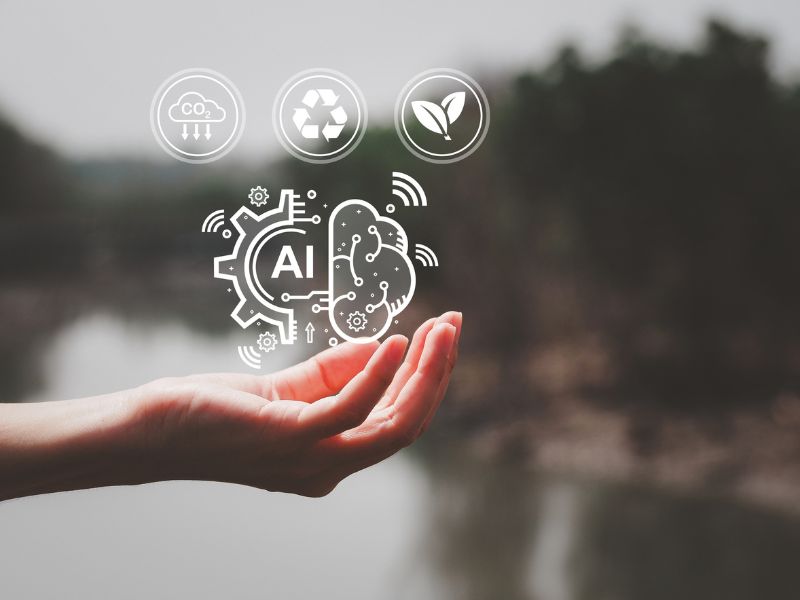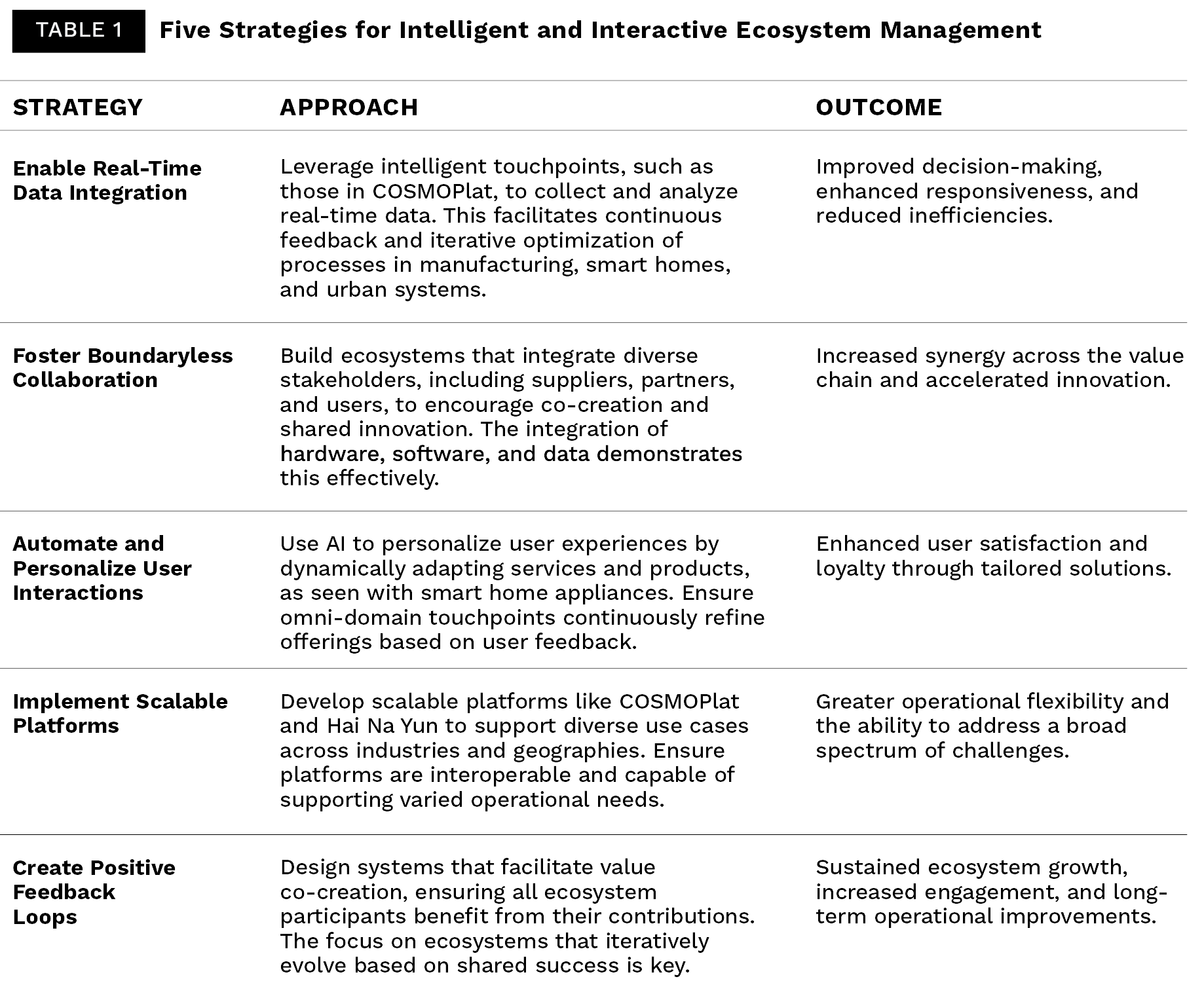By Dr. Annika Steiber and Dr. J. Mark Munoz
The rapid integration of AI into business processes across industries may lead to the false assumption that companies are adapting artificial intelligence into all aspects of organizational design. This assumption is not true. The Intelligent and Interactive Ecosystem is a new concept that seeks to help organizations maximize the power of AI in, as yet, uncharted areas.
Introduction
In the contemporary digital landscape, the integration of artificial intelligence (AI) challenges traditional organizational frameworks. While technological innovation is ubiquitous, the true transformation lies in rethinking organizational design to leverage AI effectively.
Therefore, it is necessary to utilize a new concept, the Intelligent and Interactive Ecosystem (IIE) – an emerging paradigm that redefines how organizations create, share, and sustain value in the AI era. This concept was put forward by Zhang Ruimin, the Founder of Haier and the Emeritus Chairman of the Board of Directors of Haier Group, and put into practice within the Haier Group. On September 20, 2024, based on the IIE concept, Zhou Yunjie, Chairman of the Board of Directors and CEO of Haier Group made a further explanation of the concept and launched the theory and practice exploration of the management model ‘‘RenDanHeYi 2.0’’ (RDHY 2.0).
This article delves into the uncharted “white space” of AI by examining the role of this new organizational structure, as illustrated by the groundbreaking RDHY 2.0 model.
The “white space of AI” refers to the untapped potential or uncharted areas where AI has yet to fully integrate into organizational design and strategy. In essence, it refers to the transformative opportunities where AI can redefine how organizations operate, collaborate, and create value—spaces not yet fully realized by existing business practices or structures.
As an example, the RDHY 2.0 model is a user-centric, ecosystem-driven organizational structure that transforms traditional hierarchies into self-organizing micro-enterprises (MEs) and ecosystem micro-communities (EMCs) that act as IIEs, empowering employees to create value directly for users through autonomy, innovation, and dynamic collaboration.
Emergence of intelligent and interactive ecosystems
The traditional organizational model, built for efficiency and hierarchical control, struggles to meet the demands of today’s dynamic environment. In contrast, IIE are fluid and collaborative with networks of partners, technologies, and users. Haier’s evolution from traditional manufacturing to a boundaryless ecosystem exemplifies this shift, with its RDHY 2.0 model acting as the blueprint for the new AI era. The RDHY 2.0 model offers a lens through which to understand the design of IIEs – an improvement from a previous model called RDHY 1.0.
Managers need to anticipate emerging changes and prioritize implementation to attain the greatest impact on operational performance.
RDHY 1.0 focused on zero distance between an enterprise and customers and between employees and customers and enabled Haier with a ‘‘self-organization’’ capability, which meant that the company could sense, optimize, and iterate autonomously on customers’ needs. Zero distance between an enterprise and its customers creates the self-organization capability based on a shift from a “product-centered transactional relationship” to “an interactive relationship centered on user experience upgrade.” Further, zero distance between employees and customers creates self-motivated employees. To make this empowerment possible, Haier delegated the three powers of the CEO to each micro-enterprise (ME), i.e., the right to set the strategy, the right to hire the right people, and the right to decide how to distribute generated value. The overall goal is to allow “everyone to become his or her own “CEO” and unleash human value.
RDHY 2.0 further improved the 1.0 model and switched the focus from ‘‘zero distance’’ to ‘‘zero boundaries’’ regarding user-experience, resulting in also zero boundaries for the IIE. On the demand side this means infinite interaction in user experience iteration through omni-domain intelligent and interactive touchpoints. On the supply side it means a boundaryless ecosystem which produces a positive feedback loop for value co-creation. Haier views the IIE as a new business model and as the economic engine in the AI era.
The ‘‘engine’’ in this new business model, which creates a sustainable positive evolution of the IIE is the management principle that all ecosystem partners should benefit from being part of the model and its fulfillment of value for all ecosystem partners. The company validates the IIE’s evolution through the butterfly effect, which refers to the concept that small actions or changes in a complex system can lead to significant and sometimes unpredictable consequences over time.
This approach impacts operational performance in significant ways:
- Empower Decentralized Leadership: By delegating decision making, hiring and distribution rights to micro-enterprises (MEs), managers transition from top-down control to enabling employees as “CEOs” of their domains. This requires cultivating trust, entrepreneurial mindsets, and accountabil
- User-Centric Value Creation: Managers must prioritize continuous user engagement over static product offerings, emphasizing user experience upgrades through iterative, interactive relationships. This requires new metrics to track experience-driven out
- Boundaryless Collaboration: Managers need to establish frameworks for integrating diverse partners within an ecosystem. This involves creating shared governance mechanisms to ensure fair value distribution and sustained
- Adaptive Leadership: Managers must embrace agility and develop mechanisms to respond dynamically to user feedback and ecosystem evolution. The focus shifts to orchestrating ecosystem dynamics rather than managing fixed hierarchies.
Consequently, managers need to anticipate emerging changes and prioritize implementation to attain the greatest impact on operational performance. While IIE promises transformative potential, they face several challenges that could become key opportunities. First, is interoperability. Diverse technologies and stakeholders require common standards. Haier addresses this currently through open platforms like COSMOPlat, which facilitate seamless collaboration. Second, cultural shift. Transitioning to an ecosystem mindset demands a departure from hierarchical thinking. Haier’s elimination of middle management exemplifies the bold organizational changes required. Third, scaling across contexts. Adapting ecosystem models to diverse industries and regions is complex. Haier’s success across global markets underscores the need for localized yet scalable frameworks.
Managing the “white space” of AI

AI’s potential to revolutionize industries remains constrained by outdated organizational structures. The “white space” lies not in technology itself but in its integration into value chains, decision-making processes, and stakeholder relationships. Further, traditional governance models fall short in managing the complexity of ecosystems, while IIEs demand governance that is:
(1) Adaptive – rules and structures must evolve in response to dynamic environments, (2) Transparent – trust is vital in ecosystems and governance frameworks should ensure clarity around data usage, intellectual property, and profit distribution and (3) Inclusive – ecosystems thrive when all participants benefit equitably.
The concept of IIE fills this gap by fostering collaboration across boundaries, implementing dynamic governance models, and pursuing user-centric innovation. Furthermore, AI underpins the functionality of IIE by harmonizing diverse data streams (seamless data integration), implementing proactive decisions (enhanced decision-making), and customizing interactions to engage participants (personalized user experiences).
Intelligent and interactive ecosystems in practice
Haier’s transformation into an IIE exemplifies how organizations can leverage the dynamics of infinite user interaction and boundaryless ecosystems to drive value creation. Here are three cases demonstrating this approach:
1. Industrial Digitization- COSMOPlat
Take the example of Chery Automobile, an Intelligent and Interactive Ecosystem empowered by COSMOPlat, an industrial internet platform developed by Haier:
On the user side, Chery Automobile applies the interaction big model of COSMOPlat, interacts with users in-depth, identifies 50,000 demands, creates 35 types of customization scenarios, and ultimately creates the first customized car based on the massive demand of users for off-road cars.
On the supply side, through the flexible manufacturing capability and supply chain synergy empowered by COSMOPlat, and relying on mixed-line production, Chery has improved the synergy efficiency and delivery efficiency, realizing JPH (number of cars rolled off the production line per hour) of 60, as said “one car per minute.”
Based on the Intelligent and Interactive Ecosystem, users are involved in the whole process of automobile design and manufacturing, from being “consumers” to “designers”, realizing the “customization for users”, and changing the industry from “one car for thousands of people” to “one car for one person.”
By building an Intelligent and Interactive Ecosystem, the sales volume of this model of Chery automobile increased by 10 times.
2. Smart Home Solutions – San Yi Niao
Haier’s own journey, guided by RenDanHeYi, offers a roadmap for organizations seeking to navigate this uncharted territory.
On the demand side, Haier’s AI-powered appliances, such as refrigerators with intelligent preservation technology, engage users through omni-domain touchpoints that continuously adapt to individual needs. These touchpoints iterate on user experiences by learning from usage patterns and optimizing performance dynamically. On the supply side, Haier integrates hardware, software, and data within a boundaryless ecosystem, enabling seamless collaboration between technology providers, designers, and service partners. This ecosystem fosters co-creation, ensuring that smart home solutions evolve in tandem with user demands.
Take the Smart Kitchen scenario as an example, San Yi Niao and home furnishing company Boloni established a deep co-creation partnership to integrate planning, design, and fulfillment activities with the smart modules. In 2024, customized products achieved growth five times (5X) that of the industry average.
3. Urban Management – Hai Na Yun
On the demand side, Haier’s Hai Na Yun platform facilitates infinite interaction with city administrators and residents by leveraging AI and IoT to address challenges such as transportation, public safety, and infrastructure management. These intelligent scenarios provide real-time insights and decision-making capabilities for urban environments.
On the supply side, Hai Na Yun establishes a boundaryless ecosystem by connecting various urban systems—transportation, utilities, and public services—into a unified framework. This ecosystem generates a positive feedback loop that enhances urban efficiency, improves quality of life, and drives innovation in smart city solutions.
Based on these three cases, five strategies align with the principles of Intelligent and Interactive Ecosystems (IIEs), ensuring optimized performance across operations while fostering innovation and collaboration. Table 1 highlights the Five Strategies for Intelligent and Interactive Ecosystem Management.

The impact of these strategies reconfigures the organizational framework and the way it operates. When implemented correctly, it sets the foundation for operational excellence.
Framework for operational excellence
The white space of AI is not just a technological frontier but an organizational one. Intelligent and Interactive Ecosystems redefine how businesses create and sustain value in the AI era, bridging gaps that traditional models cannot address. The RenDanHeYi 2.0 model illustrates the power of this approach, proving that ecosystem thinking is not just the future of business operations – it is imperative. As organizations embrace this paradigm, they unlock the potential of AI to drive innovation, inclusivity, and sustainable growth. It is time to design beyond the boundaries, embrace the white space, and build intelligent and interactive ecosystems that thrive in an interconnected world.
As AI matures, Intelligent and Interactive Ecosystems (IIEs) will become the dominant organizational paradigm. Their ability to integrate diverse stakeholders, technologies, and markets positions them as the white space where AI’s transformative potential is fully realized. Haier’s own journey, guided by RenDanHeYi, offers a roadmap for organizations seeking to navigate this uncharted territory.
Based on the authors’ research and case studies on Intelligent and Interactive Ecosystems, Table 2 showcases the Three Frameworks for Operational Excellence.

These strategies focus on the synergistic integration of technology, collaboration, and empowerment to redefine operational excellence in the AI era. By embracing these approaches, organizations can bridge the “white space” of AI and build resilient, adaptive ecosystems.
About the Authors
 Dr. Annika Steiber, Ph.D. in Management of Technology, is a senior executive, author, and researcher specializing in innovation management. She has authored 17 books and held positions in academia and business, including Professor and Director at Menlo College. She currently leads Management Insights and the RenDanHeYi Silicon Valley Research Center, a member of the Global Research Center Network of Haier Model Institute.
Dr. Annika Steiber, Ph.D. in Management of Technology, is a senior executive, author, and researcher specializing in innovation management. She has authored 17 books and held positions in academia and business, including Professor and Director at Menlo College. She currently leads Management Insights and the RenDanHeYi Silicon Valley Research Center, a member of the Global Research Center Network of Haier Model Institute.
 Dr. J. Mark Munoz is a tenured Full Professor of Management at Millikin University, and a former Visiting Fellow at the Kennedy School of Government at Harvard University. Aside from top-tier journal publications, he has authored/edited/co-edited more than 20 books such as Global Business Intelligence and The AI Leader.
Dr. J. Mark Munoz is a tenured Full Professor of Management at Millikin University, and a former Visiting Fellow at the Kennedy School of Government at Harvard University. Aside from top-tier journal publications, he has authored/edited/co-edited more than 20 books such as Global Business Intelligence and The AI Leader.
References
-
Arthur, W. B. (2009). The Nature of Technology: What It Is and How It Evolves. Free Press.
-
Drucker, P. F. (1999). Management Challenges for the 21st Century. HarperBusiness.
-
Gawer, A., & Cusumano, M. A. (2014). Industry Platforms and Ecosystem Innovation: Comparative Case Studies in Manufacturing and Technology. Journal of Business Strategy, 35(2), 39–50. https://doi.org/10.1108/JBS-01-2014-0001
-
Hamel, G., & Zanini, M. (2020). Humanocracy: Creating Organizations as Amazing as the People Inside Them. Harvard Business Review Press.
-
Iansiti, M., & Levien, R. (2004). The Keystone Advantage: What the New Dynamics of Business Ecosystems Mean for Strategy, Innovation, and Sustainability. Harvard Business Review Press.
-
International Organization for Standardization. (2024). ISO 56001 – Innovation Management– Innovation Ecosystem– Guidance. ISO. Retrieved from https://www.iso.org/standard/68221.html
-
Lorenz, E. N. (1993). The Essence of Chaos. University of Washington Press.
-
Schwab, K. (2017). The Fourth Industrial Revolution. Crown Business.
-
Steiber, A. (2022). Leadership for a Digital World. Management for Professionals
-
Steiber, A., & Alvarez, D. (2024). AI-driven Digital Business Ecosystems: A Study of Haier’s EMCs. European Journal of Innovation Management, ahead-of-print. https://doi.org/10.1108/EJIM-01-2024-0076
-
Wu, X., & Zhang, R. (2020). The RenDanHeYi Model: A Case Study of Haier’s Innovative Management Practices. Journal of Organizational Innovation, 7(3), 15–26. https://doi.org/10.1016/j.jorginn.2020.06.015
-
Zhang, Y., & Zhou, Y. (2020). AI and Urban Ecosystems: Insights from Smart City Frameworks. Sustainability, 12(8), 3322. https://doi.org/10.3390/su12083322
-
Zhang, R., & Zhu, H. (2022). COSMOPlat and Hai Na Yun: Platforms for Industrial and Urban Ecosystem Transformation. International Journal of Industrial Management, 14(1), 45–60. https://doi.org/10.1016/j.indm.2022.03.009
-
Zhu, H., Zhang, J., & Li, X. (2021). COSMOPlat: An Industrial Internet Platform for Digital Transformation. Journal of Manufacturing Systems, 58, 347–355. https://doi.org/10.1016/j.jmsy.2020.06.012



































